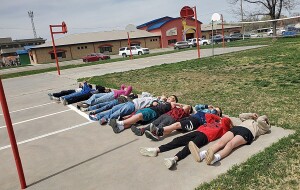Governor Sam Brownback signed a proclamation Wednesday, February 25, designating March 2-6 as Severe Weather Awareness Week in Kansas. Kansans are urged to check their emergency kit supplies for home, office and vehicles, as well as review plans to ensure they are prepared for any severe weather emergencies.
“Even though March through June typically brings severe storms, tornadoes, and flash floods, many people are still caught unprepared,” said Angee Morgan, KDEM deputy director. “Being prepared really doesn’t take a lot of time or a lot of money and while the odds are good you won’t need to use your emergency kit, it’s better to be prepared, just in case.”
Stevens County Emergency Services Coordinator Rodney Kelling reported Hugoton and Moscow will test their tornado sirens Tuesday, March 3, at 1:30 p.m. unless severe weather threatens. Please remember a Tornado Watch means conditions may be favorable for a tornado while a Tornado Warning means there is imminent danger of a tornado for the warned area. Rodney would also like to remind Stevens County residents of available shelters in Hugoton and Moscow. Hugoton citizens may shelter at the Stevens County Law Enforcement Center, 510 S. Monroe in Hugoton, or at Hugoton High School, 215 West Eleventh. Moscow residents may seek shelter at the Moscow United Methodist Church, 300 Ransom in Moscow.
Rodney also announced the annual storm spotter training will take place Tuesday, March 24, at 7:00 p.m. Stay on top of local weather alerts by finding the local National Weather Service office on Facebook, on Twitter @NWSDodgeCity, or on YouTube.
SAFETY TIPS for Tornadoes:
* Remember DUCK:
– Down to lowest level
– Under something sturdy
– Cover your head
– Keep in shelter until storm has passed
* Stay away from windows
* Get out of your automobile and into a sturdy structure or ditch OR buckle your seatbelt and stay below window level
In a Home or Small Building
* Get to an interior room in the lowest level, i.e. a closet or bathroom
* Cover yourself with coats or blankets to protect against flying debris
In Schools, Hospitals, Factories or Shopping Centers
* Get to an interior room or hallway on the lowest level
* Stay away from wide span roofs like warehouses or auditoriums
* Stay away from hallways opening to the south or west
* Centrally located stairwells are good shelter
In a Mobile Home
* Abandon it immediately. Many deaths occur in mobile homes. Mobile homes slide or overturn in 70-110 mph winds. They are completely blown away in 110-137 mph winds, or an EF2 tornado.
* Determine your shelter ahead of time.
No Suitable Structure
* Lie flat in the nearest ditch or depression
* Stay alert for flash floods
Lightning safety is very important during severe weather. If you can hear thunder, you are within striking distance and should seek shelter immediately. If someone has been struck with lightning, call 911 and get help immediately. You are in no danger from the lightning victim; the charge will not affect you. Indoor items to avoid include corded phones, computers and other electronic equipment, indoor/outdoor pools, tubs and/or showers, along with anything connected to metal plumbing.
When confronted with a flash flood, remember: never drive through flooded roadways. Turn Around, Don’t Drown! If your vehicle is caught in rising water, abandon it and seek higher ground immediately. Do not cross flowing streams, as you can’t be sure how deep the water is. The National Weather service has designated Wednesday, March 4, as Flood Awareness Day. Kansans generally don’t consider the danger of floods, but six inches of fast-moving water can knock a full-grown adult off their feet. Most flood related injuries involve vehicles; cars, even SUVs and pickups, can be swept away by just two feet of swiftly moving water.
Information about emergency preparedness and building an emergency kit can be found online here. The state has compiled a number of links that include information you need to be prepared for any number of natural or man-made disasters. To learn about preparing for severe weather, click here. Once there, you can download a checklist of crucial information to carry with you in case of an emergency, including family information, medication needs and more. You can also find out exactly what to include in your emergency kit here.
According to the National Weather Service, 40 tornadoes hit Kansas in 2014, about 40 fewer than the 30-year average of 80 and the fewest since 1989. There were 27 tornado-related injuries reported, but no fatalities. The first Kansas tornado for 2014 was reported April 2; the last was December 14, a reminder that tornadoes can strike any time of the year. The most tornadoes in one day occurred May 11 when nine tornadoes were reported in Kansas. Fortunately, the state only saw three strong tornadoes last year: two EF2s and one EF3. There were seven EF1s and 30 EF0 tornadoes. Stevens County itself has had 24 tornadoes since 1950, but none in 2014. The county has had one tornado-related fatality and five injuries from 1950 to 2014.
Make sure you and your family are prepared for severe weather this storm season by checking your emergency kits and finalizing plans this week as Kansas observes Severe Weather Awareness Week March 2-6.



